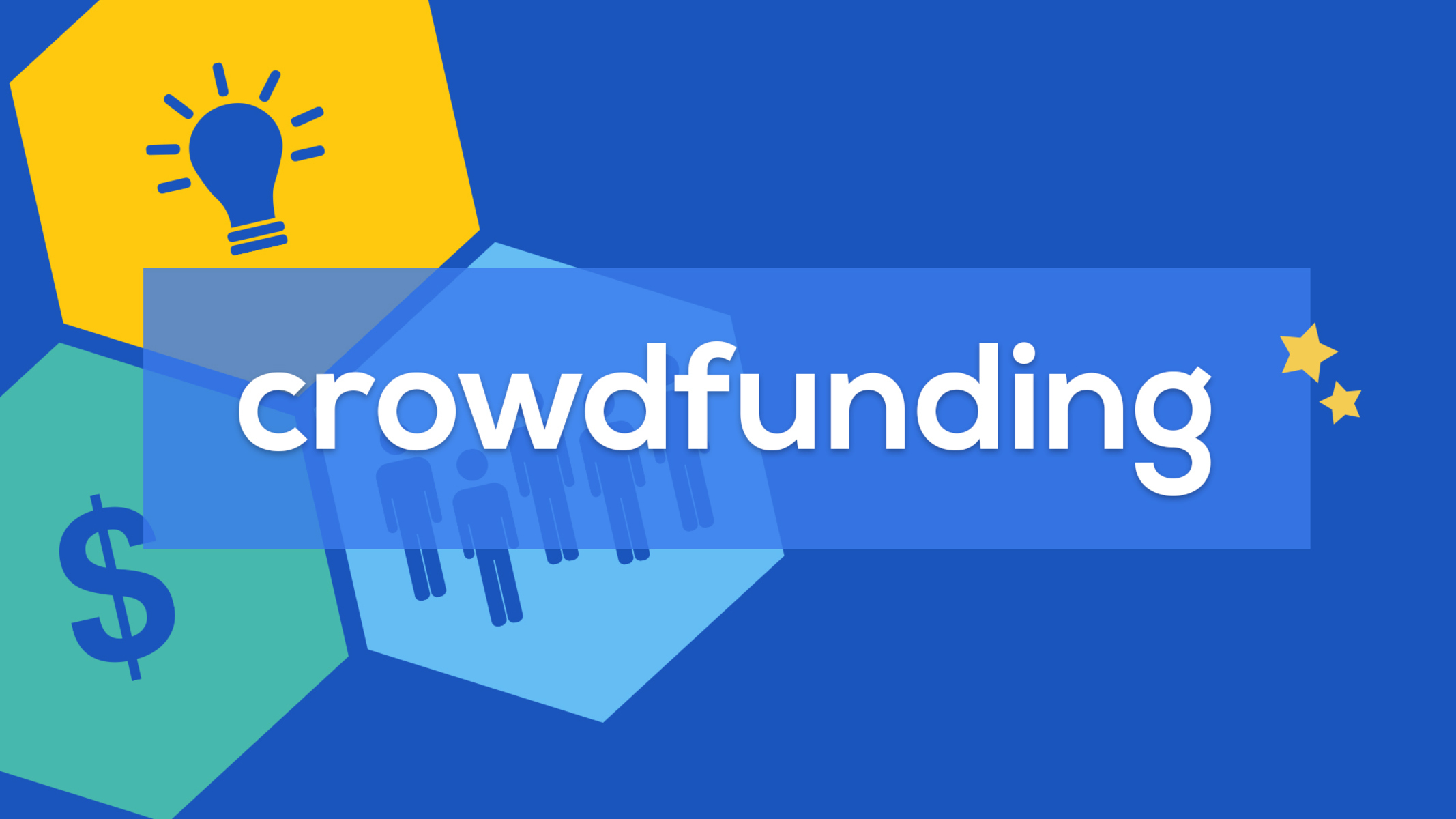What is Crowdfunding?
Crowdfunding is a revolutionary concept that has transformed the way individuals, entrepreneurs, and organizations raise funds for their projects and ideas. It is a process of gathering financial contributions from a large number of people, typically through an online platform. The funds collected from these contributors are then used to bring the project to life.
Crowdfunding offers a unique opportunity for creators to bypass traditional sources of funding, such as banks or venture capitalists, and connect directly with a diverse pool of potential backers. This democratization of funding has opened doors for innovators, artists, non-profit organizations, and individuals with great ideas to access the resources they need to turn their visions into reality.
There are several different types of crowdfunding models available, depending on the nature of the project and the desired outcome. Rewards-based crowdfunding, for example, involves offering various incentives or rewards to individuals who provide financial support. These rewards can range from exclusive merchandise or early access to the product being funded, to personalized experiences or recognition as a project supporter.
Equity crowdfunding, on the other hand, allows individuals to become investors in a company or venture in exchange for a share of the future profits or equity. This model is commonly used by startups and early-stage companies looking for funding, as it provides an opportunity for backers to participate in the potential success of the business.
Another type of crowdfunding is donation-based crowdfunding, which is often used by charitable organizations or individuals seeking financial support for a specific cause or personal need. In this model, contributors donate funds without expecting any material benefits in return, driven solely by their desire to make a positive impact.
Crowdfunding platforms play a crucial role in facilitating these fundraising efforts. Websites like Kickstarter, Indiegogo, and GoFundMe have gained immense popularity, providing creators and fundraisers with a user-friendly platform to showcase their projects, engage with potential backers, and manage the funding process.
Overall, crowdfunding has emerged as a powerful tool for innovation, creativity, and social impact. It has empowered individuals and groups to bring their ideas to life, while also fostering community support and engagement. By harnessing the collective power of the crowd, crowdfunding has reshaped the landscape of fundraising and transformed the way projects are funded and supported.
Types of Crowdfunding
Crowdfunding has evolved into a diverse ecosystem, offering different models to cater to a wide range of projects and fundraising needs. Understanding the various types of crowdfunding can help creators and fundraisers choose the most suitable approach for their initiatives. Let’s explore some of the common types:
- Rewards-Based Crowdfunding: This is the most prevalent form of crowdfunding, where backers contribute funds in exchange for rewards or incentives. These rewards can vary, ranging from a thank-you note or exclusive merchandise to early access to the product being funded. Rewards-based crowdfunding platforms like Kickstarter and Indiegogo have popularized this model, allowing creators to showcase their projects and attract backers through enticing rewards.
- Equity Crowdfunding: Equity crowdfunding enables individuals to invest in a company or project in exchange for equity or shares. Instead of receiving rewards, investors become shareholders and may benefit from the project’s future profits or growth. Equity crowdfunding offers an opportunity for small investors to support early-stage startups and potentially gain financial returns. It has become particularly popular in the entrepreneurial landscape, providing an alternative to traditional investment options.
- Donation-Based Crowdfunding: This model focuses on raising funds for charitable causes, social initiatives, or personal needs. Unlike other types of crowdfunding, donation-based campaigns primarily rely on the goodwill and empathy of contributors. Individuals or organizations seeking financial support for medical expenses, disaster relief efforts, or community projects often leverage donation-based crowdfunding platforms like GoFundMe.
- Debt Crowdfunding: Debt crowdfunding, also known as peer-to-peer lending or crowdfunding loans, involves individuals lending money to borrowers in need. In this model, lenders earn interest on their investment as the borrower repays the loan over time. Debt crowdfunding platforms provide a level of transparency and accessibility to borrowers who may have difficulty obtaining loans through traditional financial institutions.
- Real Estate Crowdfunding: This type of crowdfunding focuses specifically on real estate projects. Investors contribute funds towards property development, renovation, or acquisition and earn returns on their investment through rental income or property sales. Real estate crowdfunding platforms have emerged as a popular avenue for individuals interested in investing in the real estate market without the need for large capital.
By understanding the different types of crowdfunding, creators and fundraisers can select the most suitable model to match their project goals and target audience. Each type offers its own set of benefits and considerations, allowing individuals to harness the power of the crowd to bring their ideas to life or support causes they believe in.
Choosing the Right Crowdfunding Platform
Choosing the right crowdfunding platform is crucial for the success of your crowdfunding campaign. With the myriad of options available, it’s important to consider several factors before making a decision. Here are some key considerations to help you find the perfect platform:
1. Purpose and Project Type: Different crowdfunding platforms cater to specific project types. Determine whether your project falls under rewards-based, equity-based, donation-based, or another category. Research platforms that specialize in your project type, as they will provide the best support and audience for your campaign.
2. Platform Reputation: Investigate the reputation and track record of the crowdfunding platforms you’re considering. Look for successful campaigns similar to yours that have been hosted on the platform. Read reviews, testimonials, and case studies to gauge the platform’s legitimacy, level of customer service, and overall satisfaction of users.
3. Fees and Costs: Be aware of the fees charged by the crowdfunding platforms. These can include fees for platform usage, payment processing, and additional services. Compare the fee structures of different platforms and ensure they align with your budget and expected funding goals.
4. Target Audience: Consider the platform’s user base and whether it aligns with your project’s target audience. Look at the demographics and interests of the platform’s community to ensure you have a higher chance of reaching your desired backers or investors.
5. Crowdfunding Goals: Assess your funding goals and see if the platform supports your required funding model. Some platforms have minimum fundraising targets or particular funding structures that may not align with your needs. Choose a platform that accommodates your goals and provides flexibility in terms of funding options and targets.
6. Support and Resources: Evaluate the level of support and resources offered by the crowdfunding platform. Look for educational materials, blog articles, tutorials, and customer support channels. A platform that provides guidance and assistance can significantly improve your chances of running a successful campaign.
7. Platform Features: Consider the features and tools provided by the platform. Look for features that can enhance your campaign, such as social media integration, campaign analytics, and fundraising management tools. Evaluate the platform’s user interface and ease of use, as a user-friendly platform can simplify the campaign creation process.
Take the time to thoroughly research and compare different crowdfunding platforms to find the one that aligns most closely with your project, goals, and budget. Remember, choosing the right platform is a crucial step towards crowdfunding success, as it provides the foundation for effectively reaching and engaging your target audience.
Setting Clear Goals and Objectives
Setting clear goals and objectives is a critical first step in planning a successful crowdfunding campaign. By defining what you want to achieve, you can create a focused strategy and effectively communicate your vision to potential backers. Here are some key factors to consider when setting goals and objectives for your crowdfunding campaign:
1. Funding Target: Determine the specific amount of funds you need to raise for your project. Consider the costs involved, including production, marketing, shipping, and any additional expenses. Set a realistic funding target that aligns with the scope of your project and take into account the fees charged by the crowdfunding platform.
2. Timeframe: Decide on the duration of your crowdfunding campaign. Most platforms offer flexibility in terms of campaign length, but it’s important to strike a balance. A campaign that is too short may not give you enough time to reach your funding goal, while one that is too long may lose momentum and fail to generate excitement among potential backers. Determine a timeframe that allows for effective promotion and engagement with your audience.
3. Stretch Goals: Consider incorporating stretch goals into your campaign. Once you’ve achieved your initial funding target, stretch goals allow you to introduce additional milestones or features that you can unlock with additional funds. This can create a sense of excitement and motivation for backers to continue supporting your project beyond the initial goal.
4. Non-Monetary Objectives: While funding is a primary goal, it’s important to also consider non-monetary objectives for your campaign. Think about what other outcomes you hope to achieve, such as increasing brand visibility, building a community around your project, or gaining valuable feedback from backers. Identifying these objectives can guide your strategy and messaging throughout the campaign.
5. Timeline and Milestones: Break down your campaign into specific milestones and create a timeline for reaching them. This will help you stay organized and focused, allowing you to track the progress of your campaign and set targets for engagement, social media reach, or other key metrics. Setting milestones gives you a sense of direction and allows you to celebrate achievements along the way, keeping your campaign momentum strong.
6. Communication Plan: Develop a clear communication plan to keep your backers and potential supporters informed. Determine how often you will update your campaign page, send out email newsletters, or engage with your audience on social media. Consistent and timely communication is crucial for building trust and maintaining interest throughout the campaign.
Setting clear goals and objectives is essential for a structured and successful crowdfunding campaign. By defining your funding targets, timeframe, stretch goals, non-monetary objectives, milestones, and communication plan, you can lay the foundation for a focused and engaging campaign that resonates with potential backers.
Creating an Engaging Crowdfunding Campaign
Creating an engaging crowdfunding campaign is crucial for capturing the attention and support of potential backers. A well-crafted and compelling campaign can inspire people to contribute to your project and help you reach your funding goals. Here are some key strategies for creating an engaging crowdfunding campaign:
1. Develop a Compelling Story: Your campaign should have a compelling narrative that grabs the attention of potential backers. Tell the story behind your project, explaining its purpose, inspiration, and impact. Use storytelling techniques to evoke emotions and make a personal connection with your audience. A strong and relatable story can motivate people to support your campaign.
2. Showcase High-Quality Visuals: Visual elements play a crucial role in capturing attention and generating interest. Invest in professional-quality images, videos, and graphics that highlight your project in the best possible way. Use vibrant and eye-catching visuals to create a visually appealing campaign page that stands out.
3. Craft an Attention-Grabbing Title and Tagline: Your campaign title and tagline should be concise, impactful, and memorable. It should clearly communicate the essence of your project and entice people to learn more. A catchy and intriguing title can make your campaign stand out in a crowded marketplace.
4. Utilize Social Proof: Social proof is a powerful tool for building trust and credibility. Incorporate testimonials, endorsements, or positive feedback from previous supporters or industry experts. Highlight any awards, recognition, or media coverage your project has received. Displaying social proof can help potential backers feel more confident in supporting your campaign.
5. Engage Your Audience: Actively engage with your audience throughout the campaign. Respond to comments, questions, and messages promptly and personally. Encourage feedback and create opportunities for interaction, such as polls or contests. Show that you value your backers and involve them in the journey of your project.
6. Offer Regular Updates: Keep your backers informed and engaged by providing regular campaign updates. Share progress reports, milestones achieved, and any new developments. This shows your commitment and transparency, keeping backers excited and involved in your project’s journey.
7. Leverage Social Media and Online Communities: Use social media platforms and online communities to expand your campaign’s reach. Share updates, behind-the-scenes glimpses, and compelling visuals on platforms like Facebook, Twitter, Instagram, and relevant online forums or groups. Engage with influencers and collaborate with them to reach a wider audience.
8. Collaborate and Cross-Promote: Partner with complementary projects or campaigns to cross-promote each other. Collaborating with others in your niche can expand your reach and attract a new audience to your campaign. Look for opportunities to support and uplift other creators as well.
Creating an engaging crowdfunding campaign requires careful planning, storytelling, and active engagement with your audience. By developing a compelling story, showcasing high-quality visuals, utilizing social proof, engaging your audience, offering regular updates, leveraging social media, and collaborating with others, you can create a campaign that captivates potential backers and increases your chances of crowdfunding success.
Building a Strong Support Network
Building a strong support network is crucial for the success of your crowdfunding campaign. Having a group of enthusiastic advocates who believe in your project and actively promote it can significantly increase your chances of reaching your funding goal. Here are some strategies to help you build a strong support network:
1. Engage Family and Friends: Start by reaching out to your immediate network of family and friends. Share your campaign with them and ask for their support. They can be your initial backers and help spread the word to their own networks. Personal connections are often the most eager to support your campaign and can play a powerful role in building momentum.
2. Leverage Social Media: Utilize the power of social media platforms to expand your reach and connect with a wider audience. Share updates about your campaign regularly, including engaging content that generates excitement and encourages sharing. Engage with your followers, respond to comments, and build relationships with potential backers and influencers. Use relevant hashtags to increase visibility and reach a targeted audience.
3. Tap into Professional Networks: Leverage your professional networks, such as colleagues, industry peers, and alumni associations, to spread the word about your campaign. Engage with professional communities through forums, groups, and networking events. Seek support and endorsements from individuals with influence in your field.
4. Collaborate with Influencers: Identify influencers or thought leaders in your industry or niche who align with the values and purpose of your project. Reach out to them and propose collaboration opportunities, such as guest blog posts, social media shout-outs, or product reviews. Their endorsement and support can greatly amplify your campaign’s reach and credibility.
5. Seek Media Coverage: Approach media outlets, journalists, and bloggers in your industry or local community to cover your campaign. Craft a compelling press release and pitch your story effectively. Media coverage can bring significant visibility, attract new backers, and generate interest in your project.
6. Participate in Crowdfunding Communities: Join crowdfunding communities and forums to connect with other campaigners and potential backers. Share your experiences, ask for feedback, and offer support to others. Engaging in these communities can increase your exposure and provide valuable insights for improving your campaign strategy.
7. Host Offline Events: Consider hosting offline events, such as launch parties, pop-up shops, or demo showcases, to create buzz and connect with your local community. These events provide an opportunity to engage with potential backers in-person, share your story, and demonstrate your project’s value.
8. Offer Referral Incentives: Encourage your backers and supporters to spread the word about your campaign by offering referral incentives. This could be a discount on your product or exclusive access to additional perks. Referral incentives motivate individuals to actively promote your campaign among their networks.
Building a strong support network requires proactive outreach, leveraging online platforms, collaborating with influencers, seeking media coverage, participating in crowdfunding communities, hosting offline events, and offering referral incentives. By utilizing these strategies, you can expand your reach, gain support from various networks, and increase the likelihood of success for your crowdfunding campaign.
Crafting an Effective Pitch
Crafting an effective pitch is essential for grabbing the attention of potential backers and convincing them to support your crowdfunding campaign. A well-crafted pitch communicates the essence of your project, showcases its value, and sparks excitement. Here are some key elements to consider when crafting an effective pitch:
1. Hook Your Audience: Start your pitch with a captivating hook that immediately grabs the attention of your audience. This could be a thought-provoking question, a compelling statistic, or a powerful statement. The hook should be relevant to your project and create a sense of intrigue that makes people want to learn more.
2. Clearly Explain Your Project: Clearly and concisely explain what your project is all about. Describe the problem or need your project addresses and how it offers a unique solution. Use simple language that is easy to understand, avoiding jargon or overly technical terms. Engage your audience by painting a vivid picture of how your project can make a difference.
3. Highlight the Benefits: Clearly communicate the benefits that backers will receive by supporting your project. This could include rewards, exclusive access, or the satisfaction of being part of something innovative or impactful. Showcase how your project will improve the lives of your target audience or contribute to a larger cause.
4. Show Proof of Concept: Provide evidence that your project is viable and has potential for success. This could include prototypes, product demos, or testimonials from early adopters or beta testers. Showing proof of concept increases credibility and instills confidence in potential backers that your project can deliver on its promises.
5. Communicate your Team’s Expertise: Highlight the experience and expertise of your team members. Share their relevant qualifications, past achievements, or industry recognition. Demonstrating that your team has the necessary skills and knowledge to execute the project effectively builds trust and confidence in potential backers.
6. Create a Sense of Urgency: Instill a sense of urgency in your pitch to encourage immediate action. Emphasize that the time to support your project is now and explain any time-sensitive factors, such as limited early-bird rewards or a campaign end date. Creating a sense of urgency can motivate potential backers to act quickly and contribute to your campaign.
7. Tell Your Story: Share the story behind your project and what inspired you to pursue it. Make it relatable and personal, connecting with the emotions of potential backers. Craft a narrative that resonates with your target audience and makes them feel emotionally invested in your project’s success.
8. Use Visuals and Multimedia: Incorporate engaging visuals and multimedia elements into your pitch. This could include high-quality images, videos, infographics, or interactive elements that showcase your project’s features and benefits. Visuals can capture attention, communicate information quickly, and make your pitch more memorable.
Remember to keep your pitch concise and focused. Avoid overwhelming potential backers with too much information or getting too technical. Keep the language simple, engaging, and persuasive. Craft an effective pitch that succinctly communicates the value and impact of your project, leaving potential backers excited and eager to support your crowdfunding campaign.
Offering Attractive Rewards
Offering attractive rewards is a key strategy to incentivize potential backers and increase their willingness to support your crowdfunding campaign. Well-designed and compelling rewards can create a sense of value and excitement, encouraging people to contribute to your project. Here are some important factors to consider when offering rewards:
1. Tailor Rewards to Backer Levels: Create reward tiers that cater to different levels of support. Offer a range of options, from smaller, more affordable rewards for casual backers to exclusive and higher-value rewards for those willing to pledge more. Providing a variety of options allows potential backers to choose a reward that matches their preferences and budget.
2. Make Rewards Relevant: Ensure that your rewards are directly connected to your project. The rewards should align with the nature of your project, its purpose, and its target audience. For example, if you’re crowdfunding for a new product, consider offering early access to it or special edition versions as rewards.
3. Unique and Exclusive Rewards: Offer rewards that are uniquely available through your crowdfunding campaign. Create a sense of exclusivity by providing limited editions, personalized items, or experiences that backers can’t obtain elsewhere. Exclusive rewards can serve as a strong motivator for backers to support your project.
4. Add Value to Rewards: Enhance the perceived value of your rewards by including additional benefits or bonuses. This could be extra features, extended access, or additional products or services bundled with the main reward. Make backers feel like they are getting more than what they contribute, making the rewards even more enticing.
5. Early-Bird Discounts: Implement early-bird discounts to reward backers who pledge their support early in the campaign. Offer a reduced price or additional perks for a limited number of backers who are quick to commit. Early-bird incentives create a sense of urgency and encourage early engagement with your project.
6. Personalize Rewards: Consider adding personal touches to some of your rewards. This could include personalized messages, handwritten thank-you notes, or customizations based on each backer’s preferences. Personalization shows your appreciation and helps build a deeper connection with your backers.
7. Backer Involvement: Offer rewards that allow backers to actively participate in the project. This could include opportunities for collaboration, input into product design or features, or exclusive involvement in the development process. Involving backers gives them a sense of ownership and investment in the project’s success.
8. Transparent Shipping and Fulfillment: Clearly communicate your shipping and fulfillment plans for the rewards. Provide realistic timelines and expectations for delivery to avoid disappointment. Offering transparent information about how you plan to fulfill the rewards builds trust and demonstrates your commitment to delivering a positive backer experience.
Remember to keep the cost and logistics of the rewards in mind to ensure that they are realistic and feasible to fulfill. Strike a balance between offering attractive rewards and ensuring they align with your project’s budget. By offering well-designed and enticing rewards, you can motivate potential backers to support your campaign and contribute to the overall success of your crowdfunding efforts.
Creating Compelling Content
Creating compelling content is crucial for capturing the attention and interest of potential backers and driving engagement with your crowdfunding campaign. High-quality and engaging content can effectively communicate your project’s value, create a connection with your audience, and motivate them to support your campaign. Here are some strategies to help you create compelling content for your crowdfunding campaign:
1. Storytelling: Craft a compelling narrative that tells the story behind your project. Share the journey, challenges, and aspirations that led you to create the project. Make it relatable and emotionally engaging for your audience. Use storytelling techniques to make your content memorable and impactful.
2. Visual Appeal: Utilize visually appealing elements such as high-quality images, videos, and graphics. Visuals can capture attention, communicate information quickly, and evoke emotions. Show your project in action, highlight its features and benefits, and create a visual representation of what backers can expect.
3. Clear Messaging: Clearly communicate the purpose, goals, and unique selling points of your project. Use concise and captivating language to convey your key messages. Highlight the problem your project solves and how it provides a solution that stands out from competitors or alternatives.
4. Demonstrations and Prototypes: If feasible, provide demonstrations or prototypes of your project in action. Show how it works, its functionality, and its impact. Seeing is believing, and demonstrations can build trust and credibility among potential backers.
5. Testimonials and Social Proof: Incorporate positive testimonials and social proof from individuals who have used or experienced your project. These testimonials can demonstrate the value and impact of your project, providing evidence of its effectiveness and quality. Use quotes, reviews, or video testimonials to add credibility to your content.
6. Engaging Updates: Keep your audience informed and excited by regularly updating them on your campaign’s progress. Share milestones, achievements, and any new developments. Be transparent about challenges and how you are addressing them. Engaging updates maintain excitement and build a loyal community of backers.
7. Emphasize Benefits: Clearly communicate the benefits and value that backers will receive by supporting your project. Highlight specific rewards or perks associated with different levels of support. Show how your project will enhance or improve the lives of your target audience, with tangible examples and real-world impact.
8. Call-to-Action: Include clear and compelling calls-to-action throughout your content. Prompt your audience to take the next step, whether it’s pledging their support, sharing your campaign, or signing up for updates. Make your calls-to-action prominent, easy to follow, and enticing.
9. Share Updates and Behind-the-Scenes Content: Give your audience a glimpse into the behind-the-scenes process of your project. Share updates on your progress, challenges you have overcome, or exciting developments. This helps build trust, engagement, and a sense of involvement among your audience.
10. Engage with Your Audience: Actively engage with your audience through comments, messages, and discussions. Respond promptly, show appreciation for their support, and address any concerns or questions. Actively engaging with your audience builds a sense of community and fosters a connection with your backers.
By employing these strategies and creating compelling content, you can effectively convey the value, story, and vision of your project. Compelling content captivates potential backers, motivates them to support your campaign, and helps create a buzz around your crowdfunding efforts.
Promoting Your Campaign
Promoting your campaign is vital to raising awareness, generating interest, and attracting potential backers to support your crowdfunding efforts. A well-executed promotion strategy can significantly increase the visibility and success of your campaign. Here are some effective ways to promote your crowdfunding campaign:
1. Social Media Marketing: Utilize popular social media platforms like Facebook, Twitter, Instagram, and LinkedIn to spread the word about your campaign. Create engaging posts, share updates, and use relevant hashtags to reach a wider audience. Leverage social media ads and targeting options to effectively reach your ideal backers.
2. Email Marketing: Build an email list of interested individuals or potential backers and create an email marketing campaign to share updates and information about your campaign. Craft compelling and personalized messages that drive engagement and encourage recipients to support your project.
3. Influencer Outreach: Collaborate with social media influencers or relevant industry experts who have a substantial following. Engage with them to create sponsored posts, reviews, or shout-outs to promote your campaign to their audience. Their endorsement can significantly expand your reach and credibility.
4. Content Marketing: Create engaging and informative content that revolves around your campaign. Publish blog posts, articles, or videos that highlight the story, purpose, or impact of your project. Share this content on your website, social media, or partnering publications to attract potential backers and establish yourself as a thought leader.
5. Cross-Promotion: Collaborate with complementary projects or campaigns to cross-promote each other. This can involve sharing each other’s content, offering joint rewards, or mutually promoting campaigns to reach a wider audience. Cross-promotion can help attract new backers who may have similar interests or support other related projects.
6. Public Relations: Reach out to relevant media outlets, journalists, and bloggers to secure media coverage for your campaign. Craft compelling press releases, pitch your story, or offer exclusive interviews or insights. Media coverage can boost your campaign’s visibility and credibility, attracting more backers.
7. Online Communities and Forums: Engage with online communities and forums related to your project or crowdfunding in general. Share your campaign, participate in discussions, and offer valuable insights or advice. Be mindful of the community guidelines and avoid being overtly promotional, focusing instead on providing value and building connections.
8. Offline Engagement: Don’t neglect offline opportunities to promote your campaign. Attend relevant industry events, trade shows, or local networking events where you can showcase your project and connect with potential backers. Use offline marketing materials such as business cards, brochures, or posters to create a lasting impression.
9. Referral Programs: Implement a referral program to encourage your existing backers to spread the word and bring in new supporters. Offer incentives or exclusive rewards to backers who refer others to your campaign. Word-of-mouth promotion can be highly effective in attracting genuine interest and trust.
10. Crowdfunding Platforms: Maximize your visibility on the crowdfunding platform where your campaign is hosted. Optimize your campaign page with compelling visuals, compelling descriptions, and effective call-to-action buttons. Make sure to follow platform guidelines and engage with potential backers who show interest in your project.
Remember, effective promotion requires a comprehensive strategy that combines various channels and tactics. Be consistent, authentic, and responsive to engage your target audience and build momentum throughout your campaign. By leveraging these promotional methods, you can increase the visibility of your campaign and attract the support needed to reach your crowdfunding goals.
Engaging with Your Backers
Engaging with your backers is crucial for building a strong relationship, fostering loyalty, and ensuring the success of your crowdfunding campaign. Actively involving your backers throughout the campaign creates a sense of community, encourages ongoing support, and boosts overall engagement. Here are some effective strategies to engage with your backers:
1. Respond to Comments and Messages: Promptly and personally respond to comments, questions, and messages from your backers. Show appreciation for their support, address their concerns, and provide any necessary information or updates. Timely and thoughtful responses demonstrate your commitment to fostering a strong connection with your backers.
2. Offer Regular Updates: Keep your backers informed and engaged by providing regular updates on the progress of your project. Share milestones achieved, challenges overcome, and any new developments. This transparency builds trust and keeps backers excited and involved in the journey of your project.
3. Exclusive Backer Updates: Offer exclusive updates or behind-the-scenes content specifically for your backers. Provide them with early access to important announcements or exclusive insights into the project’s development. This sense of exclusivity makes backers feel valued and part of an inner circle.
4. Ask for Feedback and Input: Seek feedback and input from your backers, making them feel like valued contributors to your project. Ask for their opinions on design choices, product features, or stretch goals. This involvement gives your backers a sense of ownership and invests them emotionally in your project’s success.
5. Hold Live Q&A Sessions: Host live question-and-answer sessions, either through social media platforms or video streaming platforms. Allow your backers to directly interact with you, ask questions, and provide feedback in real-time. This direct engagement fosters a personal connection and builds trust.
6. Recognize and Thank Your Backers: Show gratitude and appreciation to your backers by publicly acknowledging and thanking them. Highlight their contributions, whether big or small, and express how their support has made a difference. This recognition strengthens the bond between you and your backers.
7. Incentives for Engagement: Encourage further engagement by offering incentives for your backers to participate actively. This can include exclusive rewards for sharing your campaign on social media, referring new backers, or providing feedback. Incentivizing engagement motivates backers to become advocates for your project.
8. Create a Backer Community: Establish a dedicated online space, such as a private Facebook group, forum, or Slack channel, where backers can connect with each other and with you. Encourage discussions, provide updates, and foster a sense of community among your backers. This community-building strengthens the long-term relationship between you and your backers.
9. Show Progress and Impact: Continuously show progress on your project and highlight the impact that backers’ support is making. Share photos, videos, or testimonials that demonstrate how their contributions are moving the project forward. Visual evidence of progress and impact reinforces their decision to support you.
10. Post-Campaign Engagement: Don’t forget to maintain engagement even after the campaign has ended. Keep your backers informed about the project’s continued developments, delivery timelines, and any additional opportunities for involvement or support. Nurture the relationship with your backers beyond the campaign to build a community of loyal supporters.
Engaging with your backers throughout your crowdfunding campaign is essential for building a loyal community, cultivating trust, and ensuring ongoing support. By being responsive, offering regular updates, seeking input, and fostering a sense of community, you can create a positive and interactive experience for your backers.
Managing the Funds Raised
Effective management of the funds raised during your crowdfunding campaign is crucial to ensure the smooth execution of your project and maintain transparency with your backers. Proper financial management instills trust and accountability, while also maximizing the impact of the funds. Here are some important considerations for managing the funds raised:
1. Set Up a Separate Bank Account: Create a dedicated bank account specifically for the funds raised during your campaign. Keeping the funds separate from your personal accounts helps maintain clear financial records and makes it easier to track and manage the money received.
2. Budget and Prioritize Expenses: Develop a detailed budget that outlines how the funds will be allocated for different aspects of your project. Prioritize your expenses based on the project’s needs and the promises made to your backers. Ensure that the budget aligns with your project’s goals and the financial resources available.
3. Track Expenditures: Maintain meticulous records of all expenses and payments made with the funds raised. Use accounting software or spreadsheets to keep track of each transaction, along with supporting documentation such as invoices or receipts. Accurate and organized financial records provide transparency and facilitate oversight.
4. Regularly Communicate Updates: Keep your backers informed about the use of funds by providing regular updates on how their contributions are being utilized. Share progress reports, milestones achieved, and any changes made to the budget. Transparency builds trust and reassures backers that their contributions are being utilized responsibly.
5. Allocate Contingency Funds: Set aside a portion of the funds as contingency reserves to account for unexpected expenses or changes in project requirements. This serves as a buffer in case of unforeseen circumstances and helps mitigate risks that may arise during project execution.
6. Fulfill Rewards and Promised Deliverables: Allocate the necessary funds to fulfill the rewards or perks promised to your backers. Make sure to account for manufacturing, shipping, and any associated costs to ensure timely delivery. Prioritize the delivery of the rewards to meet or exceed the expectations of your backers.
7. Seek Professional Advice if Needed: If you are unfamiliar with financial management or accounting, consider consulting with a professional, such as an accountant or financial advisor, to ensure compliance and proper handling of the funds raised. They can provide guidance on budgeting, tax implications, and financial reporting.
8. Regularly Review and Reassess Financials: Continuously monitor and assess your financial situation throughout the project. Regularly review your budget, expenses, and remaining funds to ensure that you stay on track and can make informed decisions. Be open to making adjustments as necessary to optimize the use of the funds and achieve the project’s goals.
9. Maintain Open Communication with Backers: Keep an open line of communication with your backers regarding any financial updates or changes. If there are significant changes to the budget or unexpected challenges arise, proactively inform your backers and provide explanations for the decisions made. Transparent communication maintains trust and demonstrates your commitment to responsible financial management.
10. Adapt and Adjust as Needed: Be prepared to adapt your financial management strategy as circumstances evolve. Projects may encounter unexpected expenses or changes in scope. Stay flexible and be willing to make adjustments to ensure effective and responsible use of the funds raised.
By following these guidelines, you can ensure effective management of the funds raised during your crowdfunding campaign. Proper financial management helps maintain transparency, accountability, and trust with your backers, setting the stage for a successful project execution.
Evaluating the Success of Your Crowdfunding Campaign
Evaluating the success of your crowdfunding campaign is essential to measure its performance, identify areas of improvement, and learn from the experience. By assessing the outcomes and analyzing the data, you can gain valuable insights that can inform future campaigns or project endeavors. Here are key aspects to consider when evaluating the success of your crowdfunding campaign:
1. Funding Goals: Compare the funds raised against your initial funding goals. Determine if you reached, exceeded, or fell short of your target. Analyze the trends and patterns of contribution levels throughout the campaign duration. Understanding your funding achievement provides a clear measure of success.
2. Backer Engagement: Assess the level of engagement from your backers throughout the campaign. Evaluate the number of comments, messages, and interactions received. Identify any spikes in engagement during specific campaign milestones or promotional efforts. High levels of engagement indicate a positive response and interest in your project.
3. Conversion Rate: Calculate the conversion rate by comparing the number of visitors to your campaign page with the number of actual backers. This rate helps determine the effectiveness of your campaign in converting visitors into backers. A high conversion rate demonstrates the persuasive power of your campaign pitch and messaging.
4. Social Media Reach: Analyze the reach of your campaign on social media platforms. Measure the number of likes, shares, and impressions generated from your campaign posts. Assess the effectiveness of different platforms and identify which channels drove the most traffic and engagement. Social media reach indicates the level of interest and awareness generated by your campaign.
5. Media Coverage: Evaluate the extent and quality of media coverage your campaign received. Measure the number of articles, blog posts, or interviews published about your project. Assess the reach and impact of these media mentions, including any spikes in website traffic or backer contributions resulting from the coverage.
6. Cost-Effectiveness: Analyze the expenses incurred during your campaign. Calculate the cost-effectiveness ratio to determine how efficiently you utilized resources to achieve your funding goals. Assess the return on investment (ROI) by comparing the funds raised against the total campaign costs and expenses.
7. Backer Satisfaction: Measure the satisfaction level among your backers by requesting feedback or conducting surveys. Gauge their overall experience with the campaign, including the reward fulfillment process and communication. Assess the level of satisfaction and identify any areas for improvement to enhance the backer experience.
8. Post-Campaign Activities: Assess the post-campaign activities, such as shipping rewards, communicating updates, and engaging with backers after the campaign ends. Evaluate your ability to deliver on your promises and engage your backers beyond the funding phase. Meeting or exceeding post-campaign expectations contributes to the overall success of your campaign.
9. Lessons Learned: Reflect on the overall experience and identify key lessons learned. Assess what worked well and what could be improved in terms of strategy, marketing, communication, and execution. These insights will inform your future campaigns and help you refine your approach to crowdfunding.
10. Backer Feedback and Testimonials: Pay attention to the feedback and testimonials received from your backers. Analyze the comments, reviews, and messages to gain insights about the overall user experience and satisfaction level. Positive feedback and testimonials serve as valuable social proof for future campaigns.
Evaluating the success of your crowdfunding campaign involves analyzing various metrics, assessing the level of engagement and reach, measuring backer satisfaction, evaluating costs, and reflecting on the experience. This evaluation process will equip you with valuable insights to optimize future campaigns and improve your crowdfunding approach.
Tips and Best Practices for Crowdfunding Success
Crowdfunding can be a powerful tool for turning your ideas into reality, but it requires careful planning and execution to maximize your chances of success. Here are some useful tips and best practices for a successful crowdfunding campaign:
1. Set Realistic Goals: Set realistic funding goals based on thorough research and budgeting. Consider the costs associated with your project, the scope of your campaign, and the potential reach of your target audience. Setting achievable goals increases your credibility and boosts confidence among your backers.
2. Plan and Prepare: Develop a detailed plan for your campaign, including a timeline, marketing strategies, and outreach tactics. Prepare engaging content, visuals, and rewards ahead of time to make a strong first impression. A well-prepared campaign is more likely to attract and captivate potential backers.
3. Build an Engaged Community: Start building a community of supporters and potential backers before launching your campaign. Engage with your target audience through social media, email newsletters, or events. Nurture relationships, seek feedback, and create anticipation for your project. An engaged community forms a solid foundation for crowdfunding success.
4. Tell a Compelling Story: Craft a compelling and relatable story around your project. Explain why it matters, how it solves a problem, and the impact it can make. Use storytelling techniques to connect with potential backers on an emotional level. A powerful story resonates with people and motivates them to support your campaign.
5. Leverage Your Network: Tap into your existing network of family, friends, colleagues, and acquaintances. Ask for their support and encourage them to share your campaign with their networks. Leveraging personal connections helps create an initial momentum and expands your reach organically.
6. Maximize Social Media: Utilize social media platforms to promote your campaign and engage with your audience. Create compelling content, share updates regularly, and leverage social media ads for wider exposure. Engage with potential backers, respond to comments, and build relationships to generate buzz and attract support.
7. Offer Irresistible Rewards: Design attractive rewards that align with the interests and desires of your target audience. Make them unique, exclusive, and relevant to your project. Tailor rewards to different backer levels, providing incentives for increased support. Exciting rewards can entice potential backers and drive pledge contributions.
8. Regularly Communicate and Update: Maintain regular communication with your backers throughout the campaign. Provide updates on progress, milestones achieved, and any changes or challenges faced. Transparent and timely communication builds trust and keeps backers engaged and informed.
9. Show Appreciation: Express gratitude and appreciation to your backers at every opportunity. Thank them publicly and personally for their support. Show that you value their contributions and keep them updated on how their support is making a difference. Appreciation fosters loyalty and encourages continued engagement.
10. Fulfill Promises: Honoring your commitments is essential for maintaining trust and credibility. Stay true to your promised rewards and delivery timelines. Be transparent about any challenges that may affect delivery and communicate with your backers regularly. A positive fulfillment experience contributes to the overall success and reputation of your campaign.
Remember, every crowdfunding campaign is unique, and there may be specific strategies that work best for your project. Continuously learn from your experiences, adapt your approach, and leverage the feedback and insights gained to improve future campaigns. With careful planning, effective communication, and engaging storytelling, you can increase your chances of crowdfunding success.

























